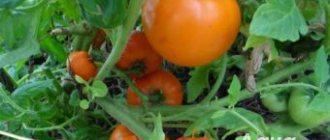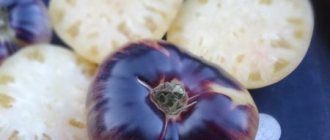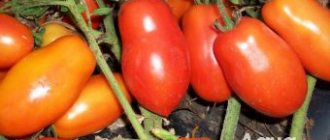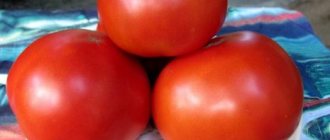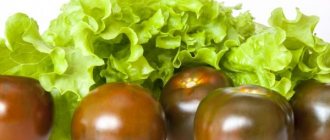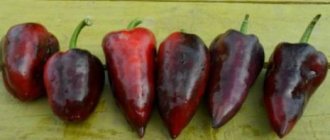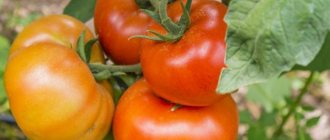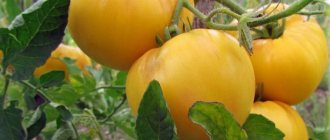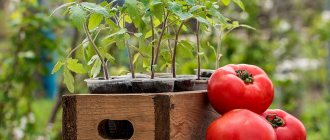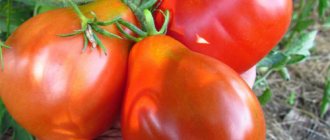What would it be like in summer without large red tomatoes? After all, this is a classic for every gardener and farmer. The Lopatinskie variety means huge harvests, a sea of delicious bright juice and fresh juicy salads. To grow them, you don’t need to know a lot or perform complex agricultural techniques.
| Height | Landing location | Ripening time | Fruit color | Fruit size | Origin | Fruit shape |
| Medium height | Greenhouse, Open ground | Mid-season | Reds | Large | Variety | Flat-round |
Fruits and yield
The variety is relatively large-fruited. The weight of the fruit ranges from 100 to 500 g. They are round and slightly flattened in shape, dense, fleshy and aromatic, with slight ribbing.
See what they look like in the photo:
The use of tomatoes is universal. They are good both fresh and in preparations for the winter (drying, pickling and pickling).
The yield of the variety reaches up to 10 kg per bush.
The fruits of the Lopatinskie variety have a long shelf life. They tolerate transportation well. This makes them attractive for growing for sale.
general characteristics
The Tretyakovsky variety is a hybrid (this is indicated by the F1 mark), it is characterized by medium-early ripening. It is resistant to various climatic conditions, so it can be grown in any region.
The plant is unpretentious and can grow well even in partially shaded areas. Such conditions do not affect the quality of fruit set.
Bushes
The variety belongs to the semi-determinate type. The bushes grow from 1.2 to 1.5 m. In the southern regions they can be higher: from 1.5 to 1.8 m.
The degree of foliage is average. The leaves are small in size. They are characterized by a dark green tint.
Fruit
The weight of one tomato is 100-130 g. Tomatoes have a round and slightly flattened shape. The fruits are characterized by a pink-raspberry hue.
The pulp is meaty and juicy. The skin is thin but durable, so the fruits can be stored for a long time, and they also tolerate transportation well.
Productivity and fruiting
The variety's yield indicators are decent: 1 bush harvests 5.5-6 kg. When planting 3 bushes, you can collect about 16 kg/m².
The most abundant harvests are obtained when grown in the Belgorod and Voronezh regions, but this is subject to planting in open ground.
Resistance to diseases and pests
This variety has a high level of resistance to diseases and pests. Well-developed immunity to:
- fusarium;
- tobacco mosaic;
- cladosporiosis.
The description indicates that among the pests dangerous to the Tretyakov tomato there may be:
- Colorado potato beetles;
- codling moths;
- whitefish.
Area of application of fruits
According to the characteristics, tomatoes are ideal for canning. They are not too large, so it is easy to screw them together.
Due to the taste of the pulp, the fruits are used to create juices. Due to the slight sourness in taste, they make excellent dressings and sauces.
How to grow a tomato
Let's consider what features need to be taken into account when growing Lopatinskie tomatoes.
Sowing seeds
Tomatoes are grown in seedlings. They are planted on average 60 days before the expected date of planting at the main site. As a rule, this is done in March.
Before planting, it is advisable to soak the seeds in a solution of a growth and development stimulator. It can be "Epin" or "Epin extra". Add 1-2 drops of Epin solution to 100-120 g of water at room temperature and soak the seeds in it before planting in the ground for 4-6 hours.
The growth stimulator will allow:
- ensure the germination of seeds;
- will protect future seedlings from pests and diseases;
- will speed up germination time.
Seedling care
When shoots appear and 2 true leaves grow, the plants are pricked (transplanted into a separate container or container). There they will remain until planting in the main place (in the ground or in a greenhouse).
Important ! Before transplanting seedlings into open ground, it is advisable to harden them - to accustom them to cooler temperatures. This is achieved by regularly placing seedlings in ventilated rooms with conditions close to outdoor conditions (for example, on a balcony).
Disembarkation at the main place
Plants are planted in the greenhouse starting in May. In open ground - later (when the threat of frost has passed on the soil, approximately at the beginning of June).
The best pattern for planting seedlings, recommended by tomato growers, is 50 cm x 60 cm in a checkerboard pattern. This means that a distance of 50 cm is left between the bushes, and 60 cm between the rows.
Caring for mature plants
To get a decent harvest, it is recommended to tie up the plants and, if necessary, remove the shoots.
It is advisable to fertilize plants with boric acid several times a season.
To prepare a working solution, 0.5 teaspoon of boric acid powder is dissolved in hot water (200 ml). The mixture is poured into 10 liters of water. The resulting solution from a spray bottle is generously sprayed onto the aboveground part of the bushes.
This foliar feeding:
- stimulates tomato growth;
- improves metabolic processes,
- increases the sugar content of fruits;
- makes the plant stronger and more resistant to disease;
Description of the Lopatinskie tomato, advantages of the variety and agricultural cultivation techniques
Each vegetable grower chooses nightshade varieties to suit his own taste; many prefer large-fruited, high-quality ones such as the Lopatinskie tomato.
Despite the fact that there is an opinion that fairly large tomatoes have a lower quality of taste, this variety is very popular and completely refutes these assumptions. The Lopatinskie tomato variety has excellent reviews from those who grew it on their plots. It is characterized as a hardy and strong plant that is not susceptible to many fungi, is resistant to weather vagaries and always produces a high yield.
You can grow Lopatinskie tomato varieties in open ground, a greenhouse or a greenhouse. The plant tolerates temperature changes well and does not tolerate prolonged drought.
Advantages of the variety
The variety description includes the following information:
- Lopatinsky tomatoes are an indeterminate species. The bushes reach a height of 0.8-1 m. An adult plant needs additional support and garter, as the tomato grows and develops in the form of vines.
- Requires formation into 2-3 trunks. This will help increase yield and affect the quality of tomatoes. Gardeners advise planting the plant, which will increase the number of clusters.
- The variety is mid-season, the first fruits appear 115 days after the first shoots.
- The bush has a strong root system. The leaf mass is dense and large. The branches are long and wide, often lying on the ground. They need to be tied up.
- The plant is hardy and unpretentious in care, easily adapts to weather changes without dropping fruits. Those gardeners who grew this tomato note that it is unpretentious to the soil, but needs regular fertilization.
- This type of tomato is resistant to late blight and tobacco mosaic. Requires protection in the form of spraying against pests.
- The yield of the Lopatinskiye variety is excellent. 10 kg of tomatoes are harvested from 1 bush per season. The bushes bear fruit for a long time, almost without interruption.
- Tomatoes are stored for about 1-1.5 months. They ripen well when semi-ripe. Gardeners prefer to pick them at the ripening stage, when the tomatoes acquire a milky color.
- The Lopatinskie tomato variety requires regular watering during the period of fruit formation. This is due to the mass and volume of the tomato.
- Taste qualities are assessed as high. Tomatoes contain a sufficient amount of sugar and dry matter and have a bright tomato aroma. The taste is pronounced, the acid is moderate.
The Lopatinskie variety is suitable for universal use. The housewife who has already planted these tomatoes in her garden appreciates their quality and says that I am planting and will continue to grow them.
Fruit characteristics:
- The fruits are large. If agricultural technology is followed, the weight of 1 tomato reaches 700-800 g.
- The tomatoes are round in shape, but slightly compressed at the top and bottom.
- The color is deep red. There are inclusions and barely noticeable stripes of a light yellow or green hue extending from the stalk.
- The tomato pulp is dense, juicy, and contains several chambers with small seeds.
- The peel is dense, but easily removed from the fruit.
- The fruits are smooth with noticeable ribbing.
- Suitable for long distance transportation.
- Tomatoes ripen gradually. About 4-5 large fruits are formed on 1 cluster.
In order for tomatoes to gain juice and taste, they need enough light and do not need additional shade.
Agricultural technology of tomatoes
Tomatoes are grown in seedlings.
Sowing is carried out 60-65 days before planting in open ground or a greenhouse.
Before planting, seeds must be disinfected with a weak solution of manganese. They are soaked in the composition for 30 minutes, after which they are laid out on a sheet of paper and dried in sunlight. Before planting, you can use a growth stimulator.
The soil for seedlings must be nutritious, so the soil should be mixed with peat and sand. All components are taken in equal quantities.
The seeds are deepened into the soil 2 cm and immediately watered with warm water. The box with planting material is covered with polyethylene and stored in a room with a temperature not lower than +20°C. As soon as the first shoots emerge, the film is removed and the box is transferred to the light.
It is important for young shoots to be warm and receive plenty of sunlight. Picking is carried out with the appearance of 2 leaves on the sprouts
Seedlings are planted on the beds according to the following scheme: 50 cm are left between holes, and 70-75 cm between rows. After 10 days, the seedlings are fed with fertilizers. The plant should be watered as needed; it is advisable to use settled water. It is worth loosening the soil and weeding the beds regularly.
Prevention of diseases and pests
In addition to spraying with a solution of boric acid against diseases, irrigating the bushes with garlic tincture to prevent pests has a beneficial effect on the bushes of Lopatinsky tomatoes. The solution is prepared from 5 liters of water and 180-200 g of chopped garlic cloves. After infusing for 3-5 hours, the liquid can be used, having first filtered it from the garlic cake.
To prevent most types of pests, it is good to plant calendula next to tomatoes. She is good at scaring away uninvited guests.
Attention ! In order to prevent diseases and pests, it is worth remembering the rules of crop rotation on the ground. Alternate crops in the garden and do not plant tomatoes in one place for several years in a row.
Planting seedlings in the ground
Of course, each gardener determines the planting time himself, based on the climate where he lives, weather conditions and the method that will be used for growing tomatoes (in open ground or indoors). As a rule, they try to plant when the return of frost has already been ruled out and the soil has warmed up sufficiently. In greenhouses this happens earlier.
When planting seedlings, you need to remember that plants growing too close will lack nutrition and light and will have to waste energy competing with each other. It is optimal when no more than three plants are planted per 1 m².
Reviews about the variety
Lopatin gardeners leave the following reviews about tomatoes:
Sweeta, Belgorod region. A productive variety, I really liked it. Planted in open ground, formed into 3 stems. The bushes were about 70 cm high. The first tomatoes weighed up to 500 g, then up to 200 g. I will grow more.
Elena, Novosibirsk. In my greenhouse, the Lopatinsky ones grew to a height of 180 cm. The overripe tomatoes lay on the seeds for a very long time and did not spoil.
Valentina, Tikhoretsk. I didn’t like the Lopatinskiye tomatoes at all (the seeds were from Sibsad). The packaging promised: productive, large. I didn’t have less than 300 g. But they taste sour and sour!
Natalya Nikolaevna, Smolensk. My Lopatinskys did not grow higher than 60 cm, both in the greenhouse and in the open ground. Without special care, the tomatoes filled up to 400 g.
Ogorodnik_77, Barnaul . This year I planted 1 bush in the greenhouse for testing (a neighbor gave me seedlings). So it was the very first to bloom for me, ahead of my early ripening hybrids. I counted only 30 fruits on the bush. They matured almost simultaneously. Next season I will plant more, the impressions were good.
Alla, Moscow region . The Lopatinskie variety in my greenhouse turned out to be tall (1.5 m) and productive. The fruits are large (up to 400 g) and fleshy. Ripened to pink color, slightly ribbed. I read that Lopatinskie produce stable yields even when the weather is not conducive to growth and ripening.
Features of care
After planting the seedlings, the seedlings do not need to be watered for a week. This is done so that the plants and their root system are more actively involved in the “work” and adapt. In the future, watering is carried out in such a way as to prevent the soil from drying out, but also to avoid waterlogging and rotting of the roots.
For this purpose, the soil around the plants is mulched, which helps to retain moisture and avoid drying out. Mulching is carried out using sawdust, straw, dry grass or compost. This procedure will also slow down the growth of weeds around the tomatoes. If mulching is not used, then, at regular intervals, the soil around the plants should be loosened in order to improve air exchange in the root system.
Approximate watering schedule:
- Before flowers appear, plants should be watered once every 3 days;
- during the period of active flowering of tomatoes and the formation of ovaries, they maintain the same schedule, only increasing the volume (if not enough);
- When the plants begin to bear fruit, water less frequently.
Reducing the amount of watering at this time is due to the fact that the abundance of moisture worsens the taste of tomatoes and makes their flesh more watery.
Additional fertilizing should be applied no more than 3-5 times per season. During the period of active growth of the stem and leaves, nitrogen fertilizers are used more. And just before flowering and the formation of ovaries - potassium and phosphorus. Excess nitrogen leads to overactive growth of the stem and leaves, which prevents the plant from moving to the stage of flower and ovary formation.
In order for the ovaries to be good and numerous you need:
- ensure that the temperature in the greenhouse does not exceed + 30 °C, otherwise the pollen will become sterile;
- plant several honey plants next to the tomatoes to attract bees;
- In the morning, gently shake the brushes with flowers so that the pollen falls off, or you can use a brush for painting.
There are some other “tricks” that can improve your harvest. For example, many gardeners tear off the lower leaves on the main cluster with flowers, and do the same with the foliage that obscures the fruits so that sunlight can penetrate unhindered.
Demidov bast shoes are recommended to be grown in “two stems”. By forming a plant bush in this way, the best result is achieved. For this purpose, the strongest stepson is left under the main brush with flowers, and all others are cut off at a height of 1.5 cm from the ground. Pruning should be done in the morning so that the “stumps” dry out during the day.
Having decided to form a bush into one stem, you need to remove all the side shoots. In the first ten days of August, the stem of the plant is pinched. The point of this procedure is that in the remaining summer days, the tomato stops growing and begins to devote all its energy to the ripening fruits.
Proper agricultural technology is the key to plant health:
- you need to take the preparation of seeds seriously, treat them and adhere to sowing dates;
- Soil rotation should be carried out, avoiding growing the same crop in the same place from year to year;
- you need to adhere to the recommended planting schemes;
- You should monitor the ventilation of greenhouses, watering and fertilizing of plants.
There are many folk, proven methods to keep plants healthy. For example, spraying them with various solutions prepared independently.
- Tomato bushes, before flowers appear, are treated with garlic solution and solutions to which such agents as Barrier, Barrier, etc. are added;
- When the first signs are detected, use the drug Oxychom.
To combat blossom end rot:
- tomato bushes are treated with calcium nitrate dissolved in water;
- monitor the regularity of watering and do not allow the soil to dry out.
They harvest fruits without waiting for them to be 100% ripe on the plant's trusses. Firstly, it is not always possible to catch such a moment in time and it is rarely “massive”, and secondly, Demidov’s bast shoes themselves will perfectly “reach” the desired condition if you take them off when they are slightly pink. With this approach, the overall speed of fruit ripening increases.
